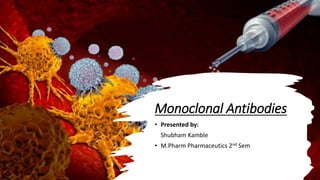
monoclonal antibody final.pptx
- 1. Monoclonal Antibodies • Presented by: Shubham Kamble • M.Pharm Pharmaceutics 2nd Sem
- 2. INDEX Basic Concepts and Introduction Structure of Monoclonal antibodies. Advantages and Disadvantages Preparation of Monoclonal Antibodies. Evaluation Application Reference
- 3. Introduction: What are antibodies? • An antibody is a protein used by immune system to identify and neutralize foreign agents like bacteria and viruses. • Each antibody recognizes a specific antigen unique to its target.
- 4. • Monoclonal antibodies (mAb) are antibodies that are identical because they were produced by one type of immune cell, all clones of a single parent cell. • Polyclonal antibodies are antibodies that are derived from different cell lines. They differ in amino acid sequence. • Immunoglobulin (Ig) are structurally related glycoproteins that function as antibodies • An antibody binds to a specific region on an antigen called an epitope. A single antigen can have multiple epitopes for different, specific antibodies.
- 7. Monoclonal Antibodies: • Monoclonal antibodies are identical immunoglobulins, generated from a single B-cell clone. These antibodies recognize unique epitopes, or binding sites, on a single antigen. • Derivation from a single B-cell clones and subsequent targeting of a single epitope is what differentiates monoclonal antibodies from polyclonal antibodies.
- 8. About 75 monoclonal antibodies are currently approved by the FDA for use in humans for treating various diseases and conditions including: cancer, chronic inflammatory diseases, transplantation, infectious diseases and cardiovascular diseases. • Glenmark, which is seeking permission from MHRA, U.K. for conducting Phase I clinical studies for one of its mAb candidate, GBR 900 mAb targeting TrkA, the receptor of nerve growth factor to tackle chronic pain. India is a fertile land for mAb market due to Large patient base, growing economy, abundant manpower and low R&D cost.
- 10. • ADVANTAGES OF MONOCLONAL ANTIBODIES Though expensive, monoclonal antibodies are cheaper to develop than conventional drugs because it is based on tested technology. Side effects can be treated and reduced by using mice-human hybrid cells or by using fractions of antibodies. They bind to specific diseased or damaged cells needing treatment. They treat a wide range of conditions.
- 11. Disadvantages of using Monoclonal Antibodies: Time consuming project - anwhere between 6-9 months. Very expensive and needs considerable effort to produce them. Small peptide and fragment antigens may not be good antigens- monoclonal antibody may not recognize the original antigen. Hybridoma culture may be subject to contamination. System is only well developed for limited animal and not for other animals. More than 99% of the cells do not survive during the fusion process - reducing the range of useful antibodies that can be produced against an antigen It is possibility of generating immunogenicity.
- 12. Preparation of Monoclonal Antibodies Monoclonal Antibody production or mAb is produced by cell lines or clones obtained from the immunized animals with the substances to be studied. Cell lines are produced by fusing B cells from the immunized animal with myeloma cells. To produce the desired mAB, the cells must be grown in either of two ways: by injection into the peritoneal cavity of a suitably prepared mouse (in vivo method) or by in vitro tissue culture. The vitro tissue culture is the method used when the cells are placed in culture outside the mouse the mouse's body in flask.
- 14. • Immunize animal. • Isolate spleen cells (containing antibody-produced B-cell). • Fuse spleen cells with myeloma cells (using PEG). • Allow infused B-cells to die. • Add aminopterin to culture and kill unfused myeloma cells. • Clone remaining cells (place 1 cell/wall and allow each cell to grow into a clone of the cell). • Screen supernatant of each clone for the presence of the desired antibody. • Grow chosen clone of cells in tissue culture indefinitely. • Harvest antibody from the culture. Practical Steps for Production:-
- 16. 1.Immunize animal . Mice are immunized every 2- 3 weeks with an antigen that is prepared for injection.
- 17. STEP 2 SCREENING OF MICE FOR ANTIBODY PRODUCTION.
- 18. STEP 3:- ISOLATE SPLEEN CELLS (CONTAINING ANTIBODY-PRODUCED B-CELL). • When the antibody titer is high enough, mice are commonly boosted by injecting antigen without adjuvant intra peritoneally or intravenously (via the tail veins) 3 days before fusion but 2 weeks after the previous immunization. • If the titer is too low, mice can be boosted until an adequate response is achieved, as determined by repeated blood sampling. • Then the mice are euthanized and their spleens removed for in vitro hybridoma cell production.
- 19. Step 4 :- Production of Hybridomas A week before cell fusion, myeloma cells are grown in 8-azaguanine (analog of guanine, acts as competitive inhibitor). Myeloma cells lack HPGRT (hypoxanthine phospho ribosyl transferase) enzyme, which is responsible for synthesis of nucleotides. The cells are then screened in HAT (hypoxanthine-aminopterin- thymidine) medium which blocks the pathway for nucleotide synthesis.
- 20. STEP 5:- SCREENING OF HYBRODOMAS .
- 23. Step :- 7 Screening for Desired Antibodies
- 25. STEP 8 :- SELECTION AND CULTURE OF SCREENED ANTIBODIES.
- 26. EVALUATION OF MONOCLONALANTIBODIES 1.Characterisation of monoclonal antibodies Physicochemical characterisation Immunological properties Biological activity Purity, impurity and contaminants Quantity 2. Specifications Identity Purity and impurities Potency Quantity General tests
- 27. Application of Monoclonal Antibodies A. Diagnostic Applications • 1.Biochemical analysis • 2. Diagnostic Imaging B. Therapeutic Applications 1.Direct use of MAbs as therapeutic agents 2. MAbs as targeting agents. C. Protein Purification
- 28. Thank You.